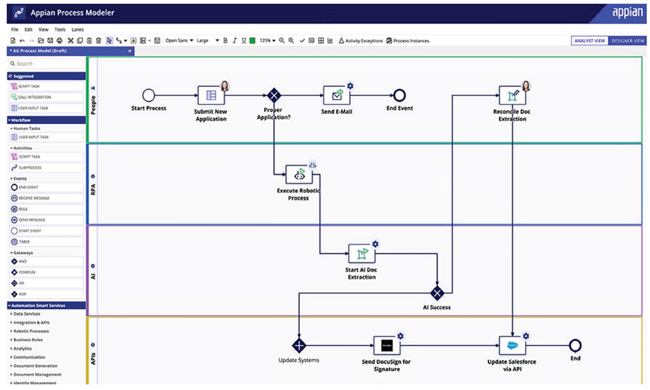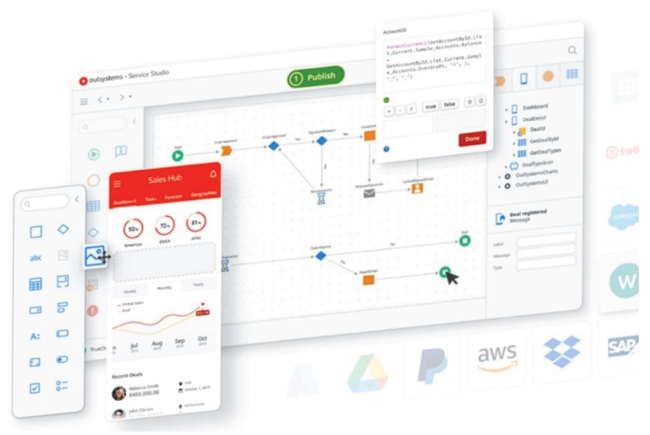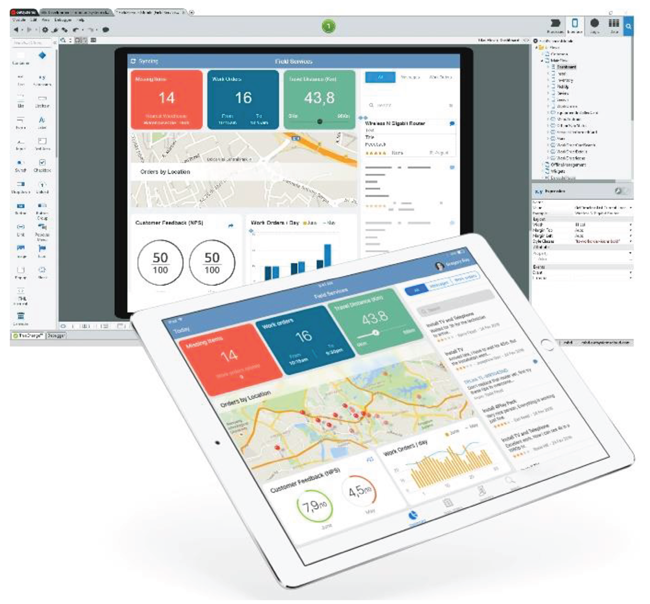
‘Low-Code’ Platforms Provide Development Tools For Business-Specific Solutions
By Ashish Deshpande
PUNE, INDIA—In the dynamic global energy environment, oil and gas companies seeking to reduce costs and optimize productivity have embraced digital technologies in a big way, but results are often slow or disappointing in their effectiveness. As a result, managers feel trapped between what seems like the obvious case for information technology investments and the risky and stressful challenges that come with making those investments deliver actual business returns.
There are two main reasons for this recurrent situation. First is the gap between a project’s ambitions and the time that experts and key knowledge holders can devote to providing complete and granular custom code development specifications. Second is the speed at which their input can be converted into working code that is ready for evaluation and deployment.
The problem is particularly acute in workflows closer to operations, where the specificities of a particular company or business result in a greater prevalence of bespoke applications. These situations are a lot less structured than back-office processes such as accounting and payroll, where commercial applications can be implemented in a fairly predictable way. They also typically lack scale, making these systems unattractive for large, packaged software companies that have no interest in developing commercial applications for problems that may be further compounded by a constantly shifting business landscape.
Practical examples of such operational processes include field inspections, equipment maintenance, drilling records, production tracking, acquisition of sensor data, personnel scheduling, competency management, etc. In each of these cases, there are opportunities for greater digitization (i.e., eliminating paper workflows), collaborative workflows and systematic accumulation of data in back-end repositories, which then can be used to drive advanced analytics and decision tools.
This is where low-code development can have the most impact. Low-code platforms are particularly well suited to develop custom applications tailored to a specific business line or set of workflows (Figure 1), or in scenarios that would be cumbersome to address with off-the-shelf software packages or customizations to core legacy applications already embedded in the enterprise. Typically, business and functional experts have limited time to devote to designing detailed IT applications. Low-code enables the rapid prototyping of screens and features that can be validated quickly by the product owner and select end users.
Low-Code Method
Low-code is an application development method that elevates coding from the textual to the visual. Unlike a traditional coding environment, in which developers manually write lines of code to produce software, low-code developers use a model-driven, visual language with a drag-and-drop graphical interface (Figure 2). Developers can create complete applications with modern user interfaces, integrations, data and logic, much faster than in traditional development processes.
From the perspective of business experts specifying an application, this is a huge advantage. They are able to see fairly quickly the developers’ interpretation of their requirements and correct course, as necessary. From the developer perspective, low-code results in an increased use of reusable components, fewer customizations, shorter testing and change cycles, easier management of hosting and interface infrastructure, and reduced developer hours.
Low-code development has gained ground in recent years with its promise of speed to market, lower risk, ease of deployment and modification, and an ultimately, better return on investment. In its December 2022 report, leading IT consultant Gartner forecast the worldwide market for low-code development technologies to total $26.9 billion in 2023, an increase of 19.6% from 2022.
As an approach, low-code is not to be confused with no-code, which tries to bring coding capabilities to business experts or “citizen developers” who are not trained in software development and complex data integrations, but have keen business insight and good ideas for improvements in the context of their specific organization and processes. No-code applications tend to be relatively simple and cater to smaller groups of people within an organization, whereas low-code applications that facilitate collaborations between business experts and low-code platform implementation experts can be more complex, and capable of handling problems of enterprise grade and scale.
Project Launch Steps
Oil and gas organizations interested in launching low-code projects can follow 10 recommended steps, which provide a basic blueprint for integrating low-code into a company’s IT landscape:
- Problem definition;
- Solution approach;
- Platform choice;
- Contracts and licensing;
- Minimum viable product No. 1 (MVP1);
- Development kickoff;
- Iterative development;
- Data integrations;
- User provisioning and application support; and
- Deployment and testing.
The process begins with appointing a project manager (PM) who can represent the business and end users throughout the project lifecycle. This individual should have the capacity to understand past efforts to improve matters, and to ascertain what worked or did not, and why. Interview knowledge holders need to distinguish IT issues and opportunities from what are essentially organizational or management issues. With this analysis, the PM then can create a high-level business description of the problem to be solved, in terms of information and data. It is important to identify the prospective users of the application, and study the tools they currently use and the pain points they experience. These tools may be IT applications, shared files, agreed procedures and communications protocols, or even paper records.
The objective in the second step is deciding on the type and scope of approach to the desired solution. Three key aspects to consider at this stage are where critical data will reside, what will be the sources of record and what security architecture is required. Assuming these elements can conform with the organization’s policies and protocols, the next step is choosing which low-code application development platform to use.
To identify the most appropriate platform, begin by short-listing a few low-code development platforms. Analyst resources such as Gartner’s Magic Quadrant and Peer Insights, G2.com and Forrester’s Wave reports can help in this task. Use vendor websites, internet research, and meetings with vendor representatives to clarify and evaluate feature sets, infrastructure models and licensing terms. Read customer stories and even speak to customers in various industries about their vendor experiences. Keep in mind that if a specific feature or module is not available, all platforms allow for custom code to be introduced alongside the prebuilt modules provided by the vendor. Other modules may have been contributed by the developer community and shared to a community site, these in turn can be adapted for your specific needs.
An important selection consideration is the availability of developers trained in the platform. Low-code platform providers typically list their development partners on their websites. If an organization already has outsourcing partners, find out if they have expertise in any specific low-code platforms. Outsourcing is generally the preferred route for the first few projects, until the platform choice has been comprehensively validated through executing representative projects.
Contracts and Licensing
Once the platform has been selected, the focus shifts to contracts and licensing. Enterprise-grade low-code platform licenses can be expensive. Aim for a contract that clearly defines license parameters. Assume that your organization’s use of the low-code platform will increase in the future, and have provisions that limit price increases and assure acceptable availability, disaster recovery and data residency.
Before finalizing a contract, organizations should complete a platform security audit with the enterprise IT Security team and seek appropriate remediation for any identified gaps. For instance, there may be legacy considerations that need re-design in a public cloud context. Ensure adequate coverage for both web and mobile implementations. If outsourcing, pricing and terms should be established with the development partner. Offshoring could be a cost-effective option if the organization has experience working with remote developers in a different time zone.
While the contract is being finalized, companies can work with the PM to identify key subject matter experts and end users who can contribute business insight, validate prototypes, and ultimately, field test the application. Together with this group, seek agreement on the feature set that will constitute the MVP1, and build a roadmap for the next two or three iterations. Ensure that critical security requirements are targeted in MVP1 itself, so that there are no surprise roadblocks in later iterations. Elaborate key user stories, which can be discussed with the developers as soon as they come on board.
The sixth step is development kick-off. Hold a workshop to bring the development team up to speed on the desired product specifications, security considerations, data sources and integrations. Establish protocols on how the team is going to collaborate and communicate about roles and software development processes. Develop a high-level solution architecture, ensuring it is compliant with the organization’s IT security norms. Develop the user experience design, including fonts and other visual conventions, in line with enterprise branding guidelines.
Iterative Development
Once the basics are in place, an agile development methodology can be followed for iterative development. The business team should be regularly involved in workflow, screen design (Figure 3), and module-level validation to ensure that MVP1 later can be tested and deployed smoothly with minimal rework.
Data integrations are a key background task that can be worked on in parallel with the front-end design. Data may need to be integrated from internal databases as well as external ones such as map databases. Security and access issues must be addressed here, especially when data must flow between the public cloud and internal data centers. For added protection, a perimeter security network (DMZ) may be necessary, and all these systems will need approval from the IT security group.
While the end user experience is in development, the application security model can be established and the user provisioning system can be set up. Arrange for a ticketing system, which is typically easiest to create within the platform as a service cloud computing environment.
The tenth and final step is deployment and testing: Mobile applications will typically need to be deployed in the context of an enterprise mobile device management tool such as Ivanti or Microsoft Intune. The low-code platform will have a standard methodology to publish Android and iOS apps to the enterprise app store. When this is complete, the application will be ready for testing by the identified user group. Collect test results, conduct a review and make changes as necessary.
Completing these 10 steps will position a typical low-code project for launch. The product owner should lead initial launch meetings, preferably in smaller groups. Ideally, the application will be sufficiently intuitive that minimal user documentation is required, but it must nevertheless be available within the app itself. Encourage the feedback process because it will help uncover anomalies and suggestions.
Once the application has launched, the focus shifts to ensuring smooth operations and quickly acting on any feedback received. The trust developed in this process is critical to making an application successful.
Low-code’s ability to rapidly implement changes and enhancements is a strength that can be used systematically to drive application adoption and user engagement, and enhance efficiency and productivity, thereby driving profitability in the oil and gas industry.

ASHISH DESHPANDE is managing partner/senior consultant of Deshpande Systems, an international consulting firm specializing in implementing business systems that optimize operations in the oil and gas industry. He previously served for more than three decades at Schlumberger (now SLB), advancing from field engineer and operations manager to senior corporate roles responsible for executing projects in enterprise architecture, supply chain and IT for various business units. Deshpande holds a B.S. in electrical engineering from the Indian Institute of Technology Bombay, and an MBA in finance from New York University.
For other great articles about exploration, drilling, completions and production, subscribe to The American Oil & Gas Reporter and bookmark www.aogr.com.









